All?gre Claude J. Isotope Geology
Подождите немного. Документ загружается.

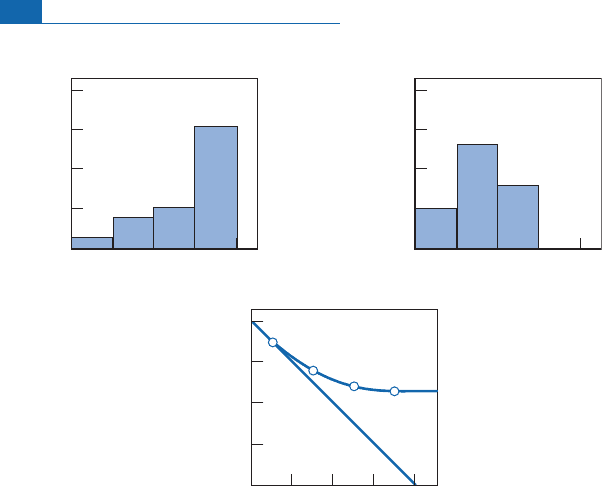
Theneodymium mod el ageand itsgeological applications
The fact that Sm/N d fractionation is almost ze ro in geological surface processes after
extraction fromthe mantle means a model age canbe attributedto any neodymium isotope
measurement of a material belonging to the crust. In an ideal scenario, this is the age at
whichthematerial(oritsprecursors)wasextractedfromthe Earth’s mantletobeginits‘‘con-
tinental geological life.’’ This is the idea hit upon by Mal col m McCul l och and Jerry
Wa s s e r b u r g oftheCaliforniaInstituteofTechnologyin1978.Nosuchmodel agecanbecal-
culated for Rb^Sr as the Rb/Sr ratio varies considerably during the surface history
(although we shall see in Chapter 7 that it can still be used for l imestone). As will be seen, it
ispossibletouse Lu^Hf in a similar mannerbecause lutetium and hafnium arealsoalmost
insolubleinwater.
To calculate this model age (which we have already come across in calculating present-
day balances of the crust^mantle system), let us consider the straight line of isotope
evolution of the closed mantle (Figure 6.31 ). Imagine that a piece of continental crust
separated from the mantle at time T
M
, and has evolved since with constant
cc
Sm/Nd
growth. This straight line of evolution intersects the time axis at
cc
Nd
.Howcanwe
calculate timeT
M
in retur n?
Let us call the two parameters of evolution of the primitive mantle
pm
Nd
and
pm
Nd
, the two
parameters for the segmentofcontinental crust
cc
Nd
and
cc
Sm/Nd
, and the common isotope
ratio corresponding toT
M
we call I.
Age provinces
20
4
23 1 0
40
60
%
80
Age (Ga)
Formation of continental
crust at expense of mantle
4 23 1 0
Geological age
Model age
1
3
2 1 0
3
4
2
Figure 6.30 Data and results of the exercise. Top: starting data. Left: proportions of continents
determined by mapping age provinces. Right: proportions of continents as a function of extraction
from mantle. (Data corresponding to the two tables.) Bottom: what becomes of the various materials
extracted from the mantle, then the model ages as a function of geological age.
269 The continental crust–mantle system

We then havethetwoequations:
Nd
pm
¼ I þ l
Sm=Nd
pm
T
M
Nd
cc
¼ I þ l
Sm=Nd
cc
T
M
:
Byeliminating I, we get:
T
M
¼
1
l
Nd
cc
Nd
pm
Sm=Nd
cc
Sm=Nd
pm
!
:
For the continentalcrust,
cc
Sm/Nd
¼0.11and for theprimitivemantle
pm
Sm/Nd
¼0. 1 96.
But
cc
Sm/Nd
pm
Sm/Nd
¼0. 11 0. 196 ¼0.086 is constant. Recalling the de¢nition of
"(0):
"
Nd
0ðÞ¼
Nd
cc
Nd
pm
Nd
pm
!
10
4
weobtain:
T
M
¼
10
4
" 0ðÞ
pm
6:54 10
12
0:086
¼0:091 " 0ðÞ:
Ifwe want an approximation of T
M
in Ga, wehave about T
M
¼0.09 "(0), which is handy
for switching from"(0) toT
M
. (Itis almost "(0) divi ded by10 with a changeofsign!)
Naturally, ifthe crustal material contains a little ofthe original mantle material, the Sm/
Nd ratio is slightly higher than 0.11an d
cc
Nd
is also a littlelargerand the previous formula is
notstrictlyapplic able. Butitprovides a ¢rst approximation.
Time
T
M
PM
I
Model age
143
Nd/
144
Nd
sample
Evolution of
primitive
mantle
Figure 6.31 Principle of model age calculation. Start from the sample. Draw a straight line of slope 0.11
cutting the straight line of mantle evolution at
I
, corresponding to the model age
T
M
.
270 Radiogenic isotope geochemistry

Exercise
We have a sediment of mixed origin: 90% is from continental crust with an average
"(0) ¼25; 10% is from the ancient mantle with "(0) ¼þ5. The Sm/Nd ratio of the
continental crust is 0.11 and that of the mantle is 0.21. It is taken that the two components
have the same Nd concentration.
(1) Calculate (0) of the sediment and its conventional model age.
(2) Calculate the model age using the Sm/Nd ratio measured on the sediment itself.
(3) Compare these ages with the model age of continental crust.
Answer
(1) 2 Ga.
(2) 2.26 Ga.
(3) 2.27 Ga.
By using the effective Sm/Nd age of the sediment, the dilution effect is ‘‘corrected’’ and we
get the age of differentiation of the continental fraction.
Exercise
If a shale is found with "(0) ¼20, what is its model age?
Answer
T
M
¼1.82 Ga.
Exercise
Supposing we apply the same formalism to Lu–Hf, given that (
176
Lu/
177
Hf)
cc
¼0.02 and
(
176
Lu/
177
Hf)
pm
¼0.036, calculate the model age of a schist whose "
Hf
(0) ¼25.
Answer
If "
Sch
Hf
(0) ¼25
Sch
Hf
¼("(0)10
4
þ1)
pm
Hf
¼0.282 24
T
¼
1
l
Hf
Sch
Hf
pm
Hf
Sch
Hf
pm
!
¼ 2:3Ga:
Neodymium model agesofgranites overgeological time
Dalila Ben Othman and the present author measured the initial isotope ratios of gran-
ites (major constituents of continental crust of varied ages) for the ¢rst time in 1979
(Alle
'
gre and Ben Othman, 1980; Ben Othman et al., 1984). The Nd model age is plotted
against geological age (Figure 6.32). If all the granites were derive d from the mantle,
the points would lie on a straight line of slop e 1. Now, this is generally so for ancient
granites ( Mont d’Or granite of Zimbabwe is a spectacular excep tion) while for more
recent granites, their model age i s much older th an their ‘‘geological age.’’ This con-
¢rms the idea of recycling wh ich increases with time. Let us try to be even more
speci ¢c.
271 The continental crust–mantle system
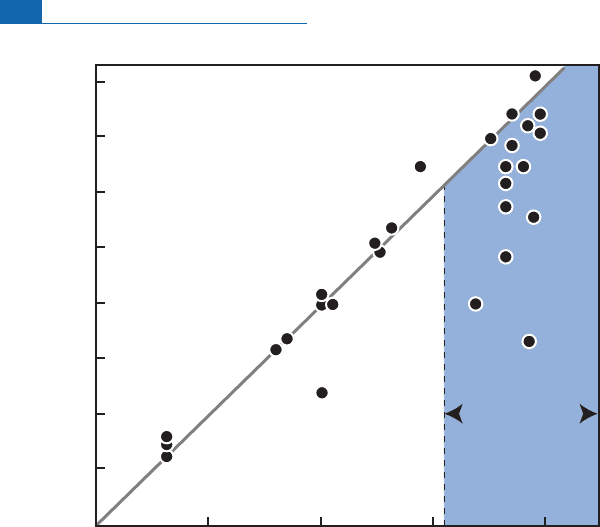
Geneticcartography ofcontinents
We have spoken of geological maps showing the di¡erent tectonic provinces which are
assembled to form the continents and we have given an overall explanation of these maps.
D on DePaol o (1981a,1981b) and hisgroup attheUniversityofCaliforniaatBerkeley under-
tooka similarapp roach (FarmerandDePaolo,1983;BennettandDePaolo,1987),consider-
ing the model ages of Nd only, that is, by trying to eliminate contin ental recycling. He and
his team studied two cases from the western United States: thatof Colorado andthe neigh -
b oring states where the age of emplacement of granites is1.8 Ga and the west of the region
(Rocky Mountains) wherethegraniteintrusions are of Tertiary age (Figure 6.33).
In the Colorado province, there is a central part formed 1.8 Ga ago an d which di¡eren-
tiated from the mantle at that time, and then bordering parts to the north and west whose
mo del age is 2^2.3 Ga. It can be seen that the 1.8 Ga materials also extend into the pro-
vince to the south in New Mexico and Texas dated 1.2^1.5 Ga. Heading west, towards the
Rocky Mountains, the Berkeley team traced isoclines with the same "
Nd
(0) value showing
that when movi ng fro m the continent toward the oceanic margin s, "
Nd
(0) becomes
increasingly positive, that is ever closer to mantle values (Figure 6.34). The percentages
of mantle material in the make-up of the granite can be calculated: they increase from
east to west.
These two examples show how continental tectonic segments are built up by addition to
an cient sediment. Probably through subduction processes, as shown in the Rocky
0
1
2
3
3 2 1 0
Nd model age (Ga)
Geological age of emplacement (Ga)
Recent
granites
Straight line of concordance
Figure 6.32 Model ages of granites of varied geological ages. After Alle
`
gre and Ben Othman (1980); Ben
Othman
et
al
. (1984).
272 Radiogenic isotope geochemistry
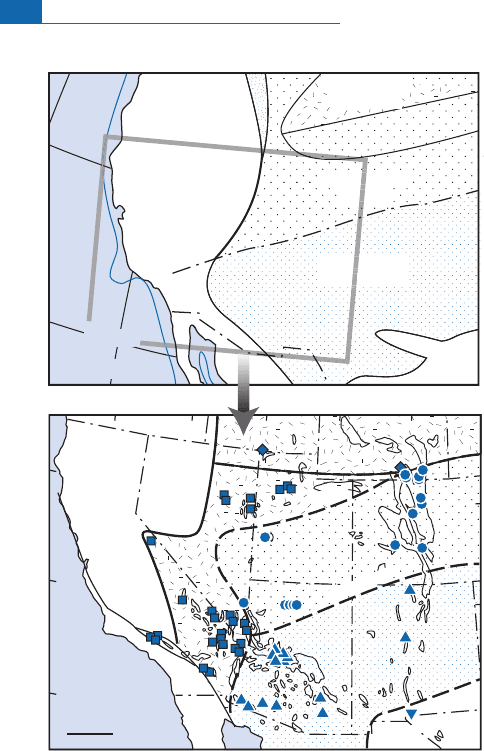
Mountains, but with reworkingand reuseofoldersediment.Ifasimilarstudyis made inthe
Himalayas, that is, in a collision range, the geographical distribution is markedlydi¡erent
butthe division between newly formed crust and recycled crust remains.The same goes for
allofEuropewherethe Caledonian,Hercynian,and Alpine orogenies essentiallyreworked
an cientpieces ofcontinentalcrust,someofwhich areveryold, as re£ected by the N d model
ages calculatedongranitesorsediments.
Wethereforehavetwoverydi¡erentsituations:
continents that have grown through new segments, which are very clearly mapped as in
Nor th Americaor Scandinavia;
continentswhereitis di⁄culttoidentifylarge age provincesbecause everything hasbeen
mixed and recycled,as in Europeand the middl e partof As ia.
200 km
32°
36°
40°
122°
114° 106°
Pacific
Ocean
SAF
T
DM
= 1.7–1.8 Ga
T
DM
= 1.8–2.0 Ga
T
DM
> 2.7 Ga
M.R.
G.C.
PENOKEAN
1.8 Ga
ALGOMAN
2.3-3 Ga
CENTRAL
1.2+1.5 Ga
0.53
1.8
1.2
T
DM
< 1.4 Ga
T
DM
= 2.0–2.3 Ga
OK
8
N
+
Pacific
Ocean
Figure 6.33 Study of Colorado granites by the model age method. Top: tectonic provinces (see Plate 5).
Bottom: provinces mapped by neodymium model ages. The two distributions do not coincide. The
difference can be explained by reworking. After Bennett and DePaolo (1987).
273 The continental crust–mantle system
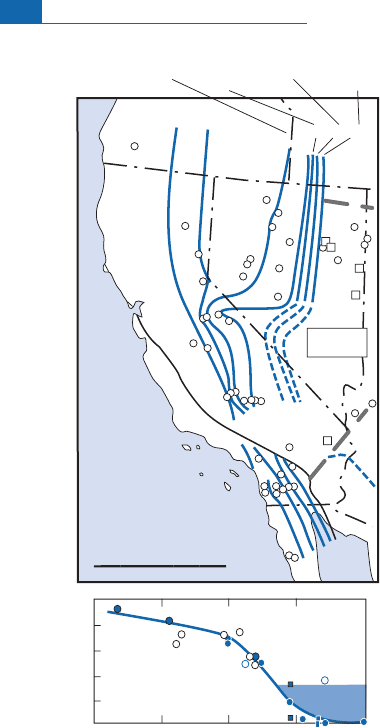
Remark
The main mechanisms of continental growth seem to be well understood. One question remains.
We have drawn a general map of the tectonic provinces. The Colorado study gives details of one
specific case. There is no doubt that continental crust in a given continent is extracted during
mountain-building episodes of well-defined ages. But is this true at the scale of all the continents?
Does not the combination of all orogenies lead to continuous extraction?
Australian detritalzircons
These ideas about dual mechanisms of formation of continental crust ^ reworking of old
materialandformation ofnewsegmentsofcontinentmaterial ^ arewonderfullyillustrated
byworkonAustraliandetritalzirconsbyChris Hawkesworth’s Bristolteamusingthelatest
insitu isotope analysistechnology (Hawkesworthand Kemp,20 06).
+6 +2
–2
–6
–10
–14
–18
+6
+2
–2
–6
GF
Pacific
Ocean
500 km
100
0
25
0
500
Distance (km)
ε
Nd
Percentage of mantle
Nd in granites
750
1
000
SAF
>
1.63 Ga
T
Nd
=
0.18 Ga
T
M
=
0.91 Ga
T
M
=
1.5 Ga
T
M
=
1.63 Ga
}
Figure 6.34 Neodymium isotope study of the Rocky Mountains in California. The curves of the "
Nd
isotope ratios are plotted. An E–W curve is shown below. The proportion of mantle decreases very
rapidly eastwards. After Farmer and DePaolo (1983).
274 Radiogenic isotope geochemistry

This work began with the analysis of detrital zircons. Zircons (ZrSiO
4
), which are prime
minerals for U^Pb radiometr ic dating, are extremely resistant to erosion.They are engen-
deredbytheformation ofgraniticrocks.They withstandweatheringvery well andaretrans-
ported mechanically and mix with clastic sediments (sandstones and, to a lesser extent,
shales). They may undergo a second phase of e rosion and be re-sedimented. At that ti me
they can mix with zirconsborn in a newgeneration ofgranites.Thus, a sandstone may con-
tain zircons ofvarious ages.This pseudo-immortality of zircons was revealed in studiesby
Le de nt et al.(1984), whowere attempting to determine a mean age for continental crustby
analyzing a zircon population. Using grain-by-grai n zircon analysis,Gau dette et al.(1981)
showedthe reweremanyepisodesofgranitization recordedin asinglepopulationofdetrital
zircons. But such studies us ing conventional methods were time-consuming and tedious.
This approach was revolutionized by the team from the Australian National University
when Bill Compstonand Ia nWi llia ms (1984) developedthe SHRIMPion probefor U^Pb
isotope analysis of zircons. Advances in automation mean that 500 zircons can now be
mounted on a plate and their U^Pb analyses completed in a matter of days. It was with this
methodthatthe Australianteamdiscovered th e existence ofzircons aged 4.3 Ga and even a
few grains aged 4.4 Ga in Precambrian clastic sediments.T hey also made a further discov-
erythathadbeen suspected for so metime. Zircongrainshave complexindividu al histories.
Around an ancient core, which is often rounded by e rosion, newgrowth zones have devel-
opedgivingthezircon crystalsthe appearanceofadoublepyramid.Thezirco n crystalscon-
tain arecordofthe di¡e rentperiods oftheir individualhistories.
This is proof, if any were needed, that some granites were forme d from the remelting of
earlier sediments, which themselves contained detrital zircons. These ancient zircons
acted as seed crystals for newadditions of zircon around them. A single zircon may tell the
complexgeological historyofaregion!
The Bristol team working in conjunction with the Australian National University team
tooka sandstone fromthe Primary period (400 Ma)as their starting point. After mechani-
cally separating the zircons, they analyzed the U^Pb ages of several hu ndre d zircons.They
alsoan alyzedthe cores ofzirconsfrom agranite dated 430 Ma.Theyobtaine d agesbetween
3.2 Ga and the age of the gran ite. A whole series of ages, with maxima and min i ma, is
shown in Figure 6.35.
Theythenu sedthefactthatzircons arerich in hafnium(Hfis theelementjustbelow Zr in
the periodic table) and very poor in lutetium.They thus managed toanalyze the Hf isotope
composition and calculate their model age for ea ch zircon, in the same way as is done for
Nd.This yielded a model age at which the material from which the zircon d erives became
separated from the mantle.The high H f content of zircon meantthis analysis could be per-
formed by laser ablation followed by ICPMS analysis. But they added a further crite rion.
They analyzed the
18
O/
16
O isotope comp osition of zircons with an ion probe. As we shall
see in the next chapter, basic magmatic rocks have very constant
18
O/
16
O compositions
with varying from 5.5 to 6.5.They therefore selected z ircons grains with
18
O < 6.5. In this
way zircons derived from materials extracted from the mantle could be selected.This dou-
ble-sorting process yielded an extraordinary result.The model ages were clustered around
twovaluesof2 Gaand 3.2 Ga (Figure 6.36).
The conclusion is that new continental crust was only formed from the mantle at these
two periods. However, conti nental crust (granites) has formed throughout geological
275 The continental crust–mantle system
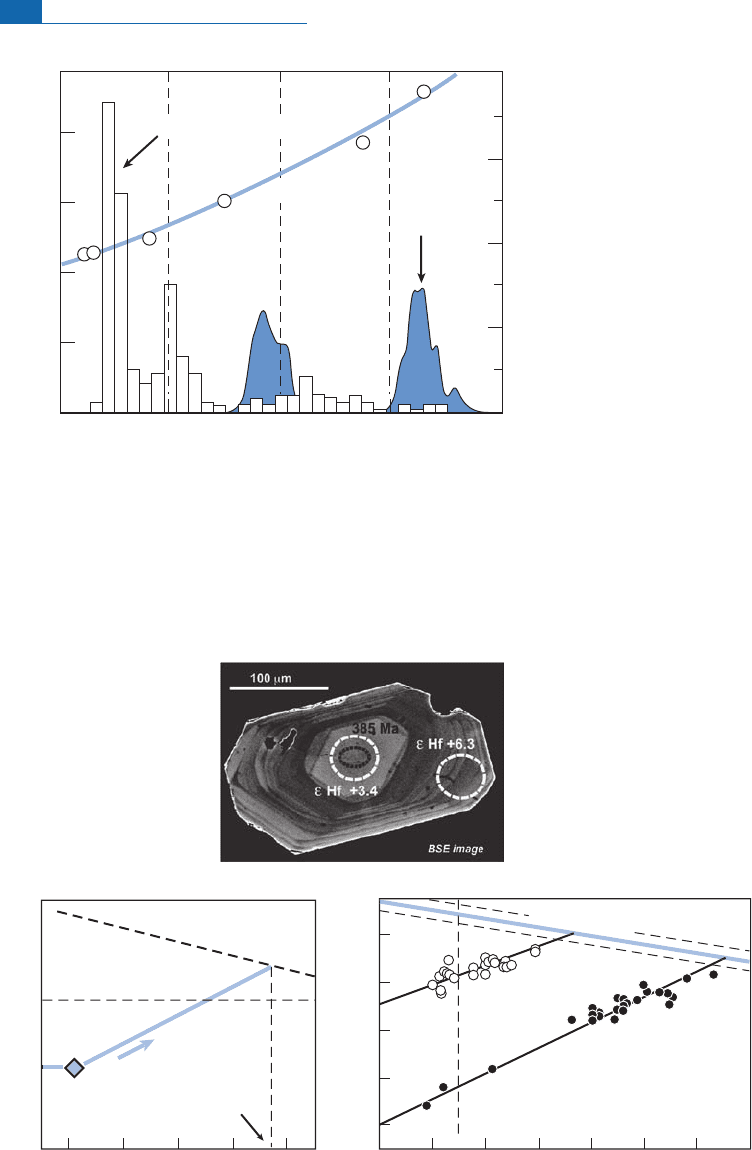
Hf model age
(δ
18
O<6.5‰)
Gondwana
sedimentary
rocks
20
40
60
4.0
3.0
80
2.0
1.0
1.0 2.0 3.0 4.00
Age (Ga)
Number
Nd model age (Ga)
U-Pb crystallization age
Nd model age
Figure 6.35 Composite zircon age diagram. The histogram in black shows the crystallization ages
determined on different zircons using an ion probe. The histogram in blue is the model age of
hafnium computed for individual zircons with
18
O < 6.5. The blue curve is the neodymium model
age obtained on Australian sediments. After Hawkesworth and Kemp (2006).
Bulk Earth
Hf model age
176
Lu/
177
Hf = 0.021
R
2
= 0.75
176
Lu/
177
Hf = 0.017
R
2
= 0.94
Zircon
Lu/Hf ratio
of average crust
depleted mantle
–30
–20
–10
0
10
1 000 2 000 3 0000
ε
Nd
Age (Ma)
U–Pb age (Ma)
ε
Hf
(t)
0
500
1000 1500 2000 2500
depleted mantle
Figure 6.36 How hafnium model ages are obtained by laser ablation ICPMS. Zircons on spot size on the
left. The principle of hafnium model age competition. Results for Australian zircons.
276 Radiogenic isotope geochemistry

histor y, as shownbyU^Pb dating, but these episod es were merely the reworkingofancient
cru st. Newthingswere made outofold!
This new method, once extende d to various region s of the planet, will indicate exactly
how continental crust formed. Did it form continuou sly throughoutgeological tim e, more
or less in relation with the activity of subduction zones, but in di ¡erent geographical loca-
tions? Ordid itformworldwide duri ng speci¢c episodesof intense activity?
When a histogram is drawn ofgeological ages measured on the various continents, peaks
arefound at600 Ma,11 00 Ma ,1600 Ma,2100 Ma,2 700 Ma,and 3200 M a.Theirdispersion is
100 Ma on average.What do these peaks mean? Are they the h eartbeat of the planet or the
re£ectionthatsomeregionslikeChinaorIndiaarestil lunder-explored?Studiesofthewestern
United States by the team from Berkeley seem to show that the formation of new continental
crust is also associated geographically with reworking processes. But is this a general result?
We can entertain high expectations of the results of this research because the method devel-
oped at Bristolandatthe Australian National Universitysuggeststhatwenowhavethe means
tosolvetheproblem.
6.4 Isotope geochemistry of rare gases
There are ¢ve rare gases.They form the ¢nal colu mn of the periodic table of the elements:
helium (He), neon (Ne), argon (Ar), krypton (Kr), an d xenon (Xe). Some isotopes of rare
gas es are produced bylong-period radioactive processes and so causevariations in isotope
abundance (Tables 6.5 and 6.6).Wehavealready referred to
4
He and
40
Ar when dealing with
geochronology (Chapter 5).The decay schemes leading to rare gas isotopes are recalled in
Table6.7.
All rare gas atoms share the common property of having their outer electron shell satu-
rated and so being chemically inert. They are transported by physical processes only and
tend to migrate upwards, towards the atmosphere where they accumulate. In the atmo-
sphere, theirbehavior varies dependingontheiratomic mass.
Helium, avery light element, is not retained by the E arth’s atmosphere as its mass is too
low.Itescapes continuouslyintospacelike(andwith) hydrogen. Neonisretainedbythe pre-
sent-day atmosphere, but it is thought that some n eon was lost in the Earth’s early history.
Argon,krypton,and xenon areretainedbytheatmosphere.Howcanthe escapeoftheseele-
ments be interpreted? As a ¢rst approximation, it can be understood quite simply. For an
objecttoescapefrom theEarth, itsvelocity mustexceedthe Earth’sgravitational attraction.
Since1/2 mV
e
2
¼mg R,thevelocityV
e
mustbe greater than
ffiffiffiffiffiffiffiffiffi
2gR
p
. Now, acceleration due to
gravity is g 10 m s
2
and the Earth’s radius R is 6400 km, therefore the escape velocity is
V
e
¼11.28 km s
1
.
Letus supposethat escapeisby thermal means only.
1
2
mV
2
e
¼
3
2
kT and V
e
¼
ffiffiffiffiffiffiffiffiffi
3kT
m
r
:
Hence:
3kT
m
4
ð11:2kms
1
Þ
2
where k is Boltzmann’s constant, Tis absolutetemperature, and m is mass.
277 Isotope geochemistry of rare gases

Table 6.5 Composition of the atmosphere
Isotope Atomicabundance (%)
Helium
30.000140
4 100
Neon
20 90.50
21 0.268
22 9.23
Argon
36 0.3364
38 0.0632
40 99.60
Krypton
78 0.3469
80 2.2571
82 11.523
83 1 1 .477
84 57.0 0
86 17.398
Xenon
124 0.951
126 0.0887
128 1.919
129 26.44
130 4.070
131 21.22
132 26.89
134 10.430
136 8.857
Majorgases
Molecular
mass Fractionby volume
Totalbalance
Bymass (kg) By volumeatstandard
temperatureandpressure
N
2
28.0134 0.78014 3.866 10
18
3.0 93 10
24
O
2
31.9988 0.2 0948 1.185 10
18
8.298 10
23
CO
2
44.0 099 (3.40) 10
4
2.450 10
15
1.24 8 10
21
He 4.0026 (5.24 0.05) 10
6
3.707 10
12
2. 07 6 10
19
Ne 20.179 (1 .8 1 8 0.004) 10
5
6.484 10
13
7.2 02 10
19
Ar 39.948 (9.34 0.01) 10
3
6.594 10
16
3.700 10
22
Kr 83.8 0 (1.14 0.01) 10
6
1.688 10
13
4.5 16 10
18
Xe 1 3 1.30 (8. 7 0. 1 ) 10
8
2. 019 10
12
3.4 46 10
17
Table 6.6 Rare gases in sea water
Concentration(atstandardtemperature andpressure)
He (1 0
8
)Ne(10
7
)Ar(10
4
)Xe(10
8
)
Surface seawater (25 8C) 3.7 1.47 2.26 0.65
Deepwater (48C) 4.22 1.85 3.51 1.1
278 Radiogenic isotope geochemistry
